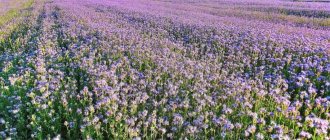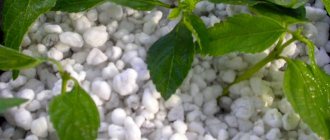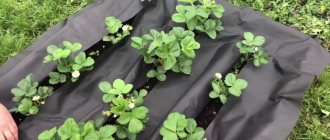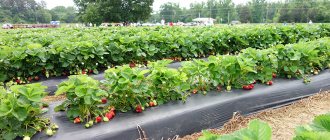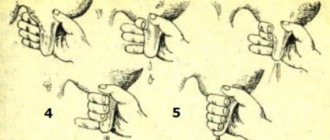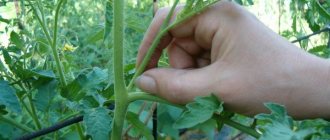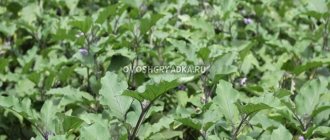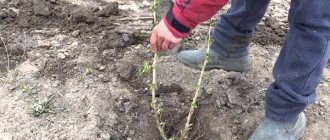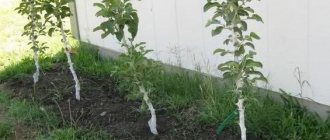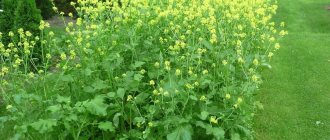The story about green manure should begin not with what a useful plant it is, but with what economic benefits can be obtained from the garden. The simplest calculations will help you understand this. A kilogram of horse manure costs about 100 rubles. Cow - 150 rubles. For one hundred square meters you need 450 kg - this is 45,000 rubles if you buy horse and 67,000 rubles if you use cow. A little expensive.
For comparison: a kilogram of phacelia seeds costs 150 rubles, the same as one kg of mullein. But in order to sow densely 100 square meters. m. area you need only 120 g - that’s almost 20 rubles. Expenses exceed income by 3,350 times. The most important thing is that the effect of 450 kg of phacelia and 450 kg of manure is almost the same.
Of course, you need to take into account that while germinating, phacelia consumes minerals. To 20 rubles you need to add the cost of a complex mineral mixture. Per hundred square meters you will need 600 g of nitroammophoska - this is about 70 rubles, because the fertilizer is sold in 1 kg packages. In total, providing nutrients to a 10x10 m area where mineral fertilizers and green manure are used will cost 90 rubles. Manure – 67,000.
You can reduce the cost by using mineral fertilizers, but we are talking about organic matter, which restores the soil and promotes the accumulation of humus and an increase in the amount of beneficial microflora. Vegetables grow better organically and have a distinctive taste rather than watery.
Labor costs when using manure and green manure are also very different. This is important when there are no special agricultural machines and all work is carried out manually. There is a difference between sowing seeds and periodically watering them or transporting carts with manure, which must be scattered across the field with a shovel and then dug up.
Conclusion! It is easier and cheaper to engage in green manure and maintain the soil in good fertile condition than to use only mineral fertilizers, which contribute to the accumulation of nitrates and reduce the fertile layer
Phacelia as green manure in a summer cottage and not only
Phacelia is a universal green manure. Those who grow green manure know that some main crops and green manure crops cannot be sown one after another, since they belong to the same species and accumulate pathogenic bacteria and fungi in the soil. Because many garden vegetable plants are legumes and cruciferous plants. Green manures used on plots also belong to this type.
Phacelia also refers to hydrophilic or water-leaf plants. Its homeland is North America. It can be sown before any crops, and also mixed with other green manure plants for greater effect.
Phacelia grass is used as fertilizer and as an ornamental plant in landscape design. It grows quite tall - up to a meter. Depending on the type, it has blue, blue or gray-blue inflorescences. The culture is very similar to a mountain plant, so when decorating alpine hills, they decorate the area with it.
In addition to its green manure qualities, phacelia green manure has useful properties:
- melliferous - beekeepers plant it for bees, since bees harvest up to 300 kg of honey on phacelia, while on other green manure plants it is from 70 to 100;
- goes to feed animals and birds - does not contain toxic substances, but has a beneficial effect on the intestines due to the presence of bactericidal substances;
- phytosanitary - protects the garden from pests - soil and ground;
- prevents weeds from taking over the area by creating a barrier with their root system, which goes 1.5 m deep.
Based on these qualities, it makes sense to sow phacelia as fertilizer, protection for the garden, or to attract bees to pollinate fruit and vegetable plants and trees.
A big plus is the fact that the plant is not susceptible to any of the diseases known to gardeners that plague garden crops. Therefore, it is planted as an intermediate link that regulates soil acidity and does not tolerate disease. Pests also do not like phacelia; they avoid those plants among which it is planted in rows.
On what soils does it grow?
Phacelia soil fertilizing grass grows on any soil. It tolerates slightly acidic soils well, but for highly acidified soils you need to select another green manure - for example, buckwheat.
It does not tolerate saline soils with large amounts of chlorides, sulfates, and sodium carbonates, especially if there is insufficient moisture. Due to the low supply of water to the tissue, the plant may die. Highly saline soils require natural farming using magnetized water to water plants.
Sowing phacelia as green manure can be done both in sunny beds and in the shade. She is not picky about where she grows.
Important! Seedlings cannot be replanted, as most plants die. You need to sow immediately in the place where the phacelia green manure will grow constantly
The plant does not really like windy areas - this makes it bloom poorly. But the decorative qualities of phacelia are not so important if it is grown as a fertilizer, which is cut off before flowering.
The crop does not tolerate soils where water stagnates. Drought is better for her than swampy areas. Low oxygen levels in such areas lead to poor seed germination and seedling death.
Fertilizing phacelia with green manure when sown thickly allows you to get more roots and green mass. There is no need to thin it out.
Varieties of phacelia
There are several types of plants:
- tansy - begins to bloom a month after planting the seeds in the soil, combines useful decorative and agricultural qualities, has increased resistance to pests and diseases, grows on any soil with varying degrees of illumination;
- twisted - intended more for decorative purposes, as it blooms for a long time;
- bell-shaped - for decorative decoration of flower beds and lawns;
- Phacelia Pursha is an ornamental variety.
Tansy phacelia is grown more often as a fertilizer for the garden; other species are more suitable for flower beds and as honey plants.
Types of phacelia, botanical characteristics
Popular varieties of phacelia.
- Bell-shaped. The annual has small inflorescences collected in tassels. Phacelia bellflower flowers are deep blue and bloom in the second half of July.
- Tansyfolia. This species is actively used in gardening. The shoots of the crop grow 45 cm.
- Twisted. The plant is distinguished by small flowers.
The stem of phacelia is thin and erect. The maximum height of the plant is 90 cm. Its leaves are pinnate, alternate, covered with villi. Several flowers form compact curls. The corolla resembles a bell. Phacelia forms flowers 2 months after sowing the seeds. It does not place high demands on soil composition. Phacelia takes root:
- in loam;
- in black soil;
- in soil with peat.
Phacelia green manure thrives in the sun. However, if it is not possible to place it in a lighted area, you can plant it in shade or partial shade. Phacelia seeds germinate at a temperature of + 4 degrees. The plant requires moderate watering. The roots should not be allowed to become waterlogged. This problem leads to fungal diseases.
It’s not difficult to buy phacelia seeds! The advantage of the culture is that it grows quickly. Phacelia is frost resistant. If it grows in a cold climate, it produces less nectar. Phacelia is often used as green manure. It is also valued for its decorativeness. Some summer residents plant this plant instead of lawn grass. Phacelia promotes pollination of nearby crops.
Features of cultivation
Since the plant is cold-resistant and can withstand frosts up to 10 degrees, it can be sown in early spring, as soon as the snow melts. The seed material is also frost-resistant, so air and soil temperatures do not affect germination.
During the season you can get fertilizer from planting phacelia 4 times. From the moment of sowing to the flowering phase of tansy phacelia, one and a half months pass. Immediately after mowing, you can re-sow the plants.
How to sow phacelia:
- first time - early May;
- second – mid-June;
- third - beginning of August;
- fourth - mid-September.
If the bed is completely intended for green manure, then sowing and harvesting are carried out one after another. The roots remain in the ground and rot. Green mass is used:
- for preparing green fertilizer in a barrel for watering garden crops;
- for mulching beds;
- added to compost;
- goes to animal feed.
Before the first spring planting, you need to add mineral fertilizers to the soil at the rate of 60 g per square meter so that the green manure has something to eat. This investment is not wasted because it is returned to the soil in the form of organic fertilizer rich in nitrogen, potassium and phosphorus.
One season can completely restore soil fertility. It is enough to plant phacelia or a mixture of green manure in a depleted bed several times, and next year you can already get a rich harvest of vegetables or berries.
This method is used for the capital restoration of “killed” soils, to which organic matter has not been added for a long time and the fertile layer has been completely depleted. On average, it takes two seasons to grow vegetables on such soil.
Autumn planting
Phacelia green manure is used in the fall to restore and fertilize the soil between vegetable planting seasons. This method is called intermediate. The time for planting phacelia is September or in warm regions – October. In the fall, the plants have time to grow and go under the snow uncut.
During the winter, the above-ground part decomposes by half and serves as mulch to retain moisture. The root system rots, leaving voids in the ground into which oxygen and water easily penetrate. In such an environment, soil microorganisms and earthworms develop well, eating plant debris and releasing their metabolic products into the soil.
In the fall, another method is used that eliminates digging up green manure with soil. Cut greens are left in the garden bed or between rows and mulched with straw. Until spring, plants rot in a humid environment. In the spring, the straw is removed and the bed is dug up, but you can do without this procedure.
Why it is not good to dig up the soil:
- Soil microorganisms live at a depth of up to 30 cm. If you turn over the top layer, most of them will appear on the surface and die from exposure to ultraviolet radiation and without water.
- The humus formed with the help of microorganisms erodes, and the soil dries out.
To minimize impact on the soil and not interfere with bacteria doing their work, it is recommended to use a flat cutter. Its width and length will depend on the type of soil on the site. The tool is designed to remove the top part of the plant, allowing only the roots to remain deep. It is convenient to mow green manure with a flat cutter.
What must be done before the autumn planting of phacelia as green manure:
- completely remove the crop from the garden;
- remove weeds;
- use a flat cutter to lift the top layer of soil;
- apply mineral complex mineral fertilizer, scattering it over the area;
- scatter the seeds;
- pour plenty of water
Important! If you do not feed the crop, phacelia green manure will take the remaining nutrients from the soil and it will take time to restore the balance of nutritional components
When to sow in spring
Immediately after the snow melts, you can sow the seeds. Shoots appear in 1.5 - 2 weeks. The plant quickly gains greenery, blooming within a month. At this point, it is important to cut off the tallest stems to prevent them from becoming rough.
Important! Seeds do not germinate well in the light, so a prerequisite for germination is embedding 2 - 3 cm into the soil. To do this, the seeds are mixed with sand 1:1 and planted in recesses - rows, or scattered over the area, sprinkled with soil
In spring, it is better to mix phacelia with legume green manure - this increases the amount of green mass and shortens the growth period.
In order for green manure to germinate 2 weeks earlier in the spring, it is recommended to plant the seeds before winter before the cold weather - this is the middle or end of October.
Mulching with plants
The procedure is needed to protect crops from the negative influence of external factors. Green manure, such as mustard and phacelia, can be used as mulch. Thanks to the natural layer, the soil retains valuable substances longer.
Other benefits of mulch:
- does not form a rough crust on the surface of the earth;
- inhibits weeds and prevents their growth;
- protects crops from pests;
- increases the activity of earthworms (they make the soil looser and more fertile).
There is an organic and inorganic method of mulching. The latter involves the use of film, roofing felt, and plain paper. To perform a useful procedure, phacelia is used. The plant can be mixed with fertile soil, sawdust, or any other organic material. High-quality mulch allows air to pass through and retains moisture. The procedure increases the quantity and quality of the harvest.
Phacelia has many advantages as green manure when we already know how to sow the crop. To get high-quality organic fertilizer, you need to properly care for the plant. The main thing is to avoid over-wetting the roots!
When to mow phacelia
They try to cut off all green manure plants before they bloom. There are several reasons for this:
- During the flowering phase, shoots and leaves become coarser. When embedded in the ground, they take longer to rot.
- Until flowering, crops accumulate nutrients so that more seeds ripen. During the flowering period, these substances begin to be spent on the formation of buds and seed boxes. The nutritional benefits of green manure are reduced.
- If you do not have time to cut before the phacelia green manure blooms, you may miss the moment of seed ripening. Since the plant reproduces by self-seeding, it is possible to allow the uncontrolled spread of the crop, which will then have to be removed or limited in growth.
When planting in spring, in early May, before the main crop, the phacelia is mowed a month later, until flowering. The green mass at this moment is already quite large and can saturate the soil with nitrogen and phosphorus.
Phacelia: description, photo
People have long noted that after certain plants, other crops feel better. Thus, green manure was born. It dates back to Ancient Rome, whose inhabitants had already mastered the basics of organic farming.
Phacelia belongs to the borage family and is widespread in the California Valley and Mexico. It is an annual plant that can reach a height of 70-100 cm in a short time. The stem is pubescent with glandular hairs and branches weakly. The lower leaves are located on long petioles; as they move up the trunk, the petiole size decreases. The leaves are heavily dissected and somewhat reminiscent of thuja branches.
The special charm of this useful plant is its numerous blue flowers. They have a very decorative appearance, so they are often used to decorate the garden. Small flowers are collected in a complex umbrella inflorescence, on which there can be up to 70 of them. They have a wide bell-shaped shape and consist of 5-7 petals.
In the center there are very long bare stamens equipped with large anthers. The aroma emitted by the plant attracts pollinators. The flower is an excellent honey plant.
Flowering begins 1.5 months after emergence and lasts about a month. Each flower lives no more than two days, and then turns into a wide oval box. Inside there are two wrinkled brown seeds about 2-3 mm long. Due to the short life cycle of each flower, both buds and seeds can be found on the umbrella.
This is interesting! The word phacelia is Latin for “bundle.” This is what the inflorescences of this green manure resemble.
Beneficial properties for soil and plants
Green manure grasses - phacelia, lupine, clover, alfalfa and others - enrich the soil with nitrogen, which is necessary at the initial stage of growth of garden crops - vegetables, berries, fruit trees. Green manure tissues contain potassium and phosphorus, which are necessary for fruit set and root system growth. In terms of ratio, green fertilizer is superior to manure, since it does not contain phosphorus. It has to be added in the form of mineral salts.
But the most important thing is organic matter, the amount of which in the soil affects its characteristics. If there is little organic matter, the soil is susceptible to water erosion and weathering. The color of the soil changes from rich black to gray. Beneficial bacteria feed on organic matter; if there is little of it, the microorganisms die and the soil becomes even more depleted.
Video: An interesting story about phacelia
When the acidity changes in the soil, lovers of an acidic environment appear - nematodes and wireworms. You can’t expect a good harvest after them. Sick plants develop fungus and bacterial root rot.
All the consequences of depletion of the soil fertile horizon can be cured using the green manure method by planting companion plants as intermediate or independent crops.
The method does not contribute to the accumulation of nitrates and is completely harmless to plants and humans.
How to sow correctly
Correct sowing technology is no less important. This can be done in two ways:
Between vegetables and berries, green manure is sown between rows. To do this, make a long furrow and spread the seeds evenly. There is no need to dig up the area before planting, just loosen it a little. The planting is carried out to a depth of 1.5-2 cm. After this, abundant watering is carried out. In the future, there is no need to water the plantings; rain is enough.
To saturate a large area with humus and minerals, loose sowing is used. Since the seeds are small in size and brown in color, it is very difficult to see them on the ground.
Gardeners use a little trick: they mix the material with sand or sawdust. So, it will be clear where the seeds went, and where their quantity should be added. The planting rate is 100-200 grams per hundred square meters. When planting before winter, you should take into account that severe freezing will reduce germination. Double the mass. There is no need to dig up the soil, just walk over the surface with a rake. They also seal the planting.
If planting is done immediately after the snow melts, additional irrigation is not necessary. If there is a lack of moisture, the sown area should be watered.
On a note! The seeds have a thin shell, so they have high germination rate.
No additional preparation of the material (soaking, hardening, germination) is required.
How to apply - under what crops
For each vegetable there are special recommendations on how best to sow phacelia. Suitable for most vegetables. For some, it is not even necessary to mow down green fertilizer - you can plant it between green manures.
Phacelia and tomatoes
You can plant tomato seedlings directly between planting green manure plants. You don’t have to mow it, but wait until the seedlings take root. In the spring, when the weather has not yet improved, and the seedlings are small and survive transplantation into open ground, thickets of phacelia shelter them from the wind and protect the root system from pests and rot.
When the tomatoes grow, the root system is left to rot, and the top part is cut off and placed under the tomato bushes. This helps retain moisture. You can lay a layer of straw on top so that the mulch also rots.
During the entire growing season, the main crop - tomatoes - will be provided with nutrients and moisture. After harvesting, you can use a mixture of green manure and sow the area after the tomatoes with phacelia and mustard.
Phacelia and potatoes
To enrich the soil with nitrogen and phosphorus, you need to combine autumn and spring plantings of green manure. In this case, it is better to sow phacelia in the fall, and nitrogen-fixing ones - peas, beans - in the spring before planting the tubers.
When to sow phacelia in the fall and when to cut green manure depends on climate conditions. If it is southern and warm, you can sow in October. The seedlings will die and rot in winter. In the spring, legumes are sown in their place, they wait until the plants gain green mass - 1 month, cut them and dig them with soil. You need to wait 2 weeks for the plant debris to rot. Next, potatoes are planted.
A 50x50 mixture of phacelia and legumes goes well with potatoes. Legumes attract nitrogen, which is beneficial for the tubers; phacelia protects them from wireworms and other insects. Green manure is sown in strips next to potato bushes.
Phacelia and melons - cucumbers, pumpkin
Cucumbers greatly deplete the soil, removing a lot of nutrients from it. If you use only green manure farming, then planting is needed both before and after cucumbers.
Sowing green manure phacelia in front of cucumbers in the spring means protecting them from nitrogen starvation, suppression of the root system due to lack of phosphorus, and falling of the ovaries due to potassium deficiency. A deficiency of any element leads to fungal infections. Cucumbers can be grown in one place several times in a row only in the presence of phytosanitary agents, such as mustard, phacelia, and rye.
After harvesting, you need to disinfect the soil. Green manure is sown, which inhibits the development of pathogenic microflora.
Phacelia and cabbage
Cabbage seedlings can be planted in the holes between the phacelia. It is not recommended to use cruciferous green manure to prevent the cabbage from getting sick. After the cabbage has rooted, the phacelia is cut off at the root and the soil is mulched between the rows. The roots, rotting, serve as food for vegetables, and the greens retain moisture and also release nutrients into the soil. If there is a large amount of greenery, it is used for fermentation in barrels and the garden is watered with the solution.
Strawberry, raspberry and phacelia
Berry crops benefit from the proximity of phacelia and other green manure because they attract bees for pollination. Productivity increases, since there are practically no empty flowers on strawberries, raspberries, and blackberries.
The best plant fertilizers for strawberries are considered to be lupine and phacelia, as well as legumes with their ability to accumulate nitrogen and release it to neighboring plants. If strawberries have not yet grown on the site, but you are only planning to plant bushes, then before spring or autumn planting strawberries, it is recommended to sow green manure to improve the quality of the soil and enrich it with nutrients.
Before planting the bushes, green manure is mowed, strawberry bushes are planted in the garden bed, then mulched with green shoots and leaves. For good rooting, it would be good to place sawdust or straw on top of the phacelia. This layer protects the soil from drying out and drives away pests. When ripened, the berries remain dry and are less likely to be damaged by fungal spores that travel through the air.
Green manure is especially helpful for raspberries. It has a superficial root system. At the slightest drought, nutrition is disrupted. If the soils are sandy or sandy loam, then the soil quickly becomes poor, because useful substances are washed into the lower horizons, from where they cannot be obtained.
Sowing phacelia in the spring between raspberry thickets helps move nutrients closer to the roots. The rotting roots of green manure provide the raspberries with everything they need for fruiting, and the green mulch nourishes them throughout the entire growth period. It harbors earthworms, which loosen the surface layer, giving oxygen access to the roots.
What are the benefits of sowing phacelia for the soil?
This wonderful plant is multifunctional; it will help solve several problems at once:
- At a rate of 100-200 grams of seeds per hundred square meters of land, in a short growing season you will receive about 200-300 kg of useful biomass. Its subsequent incorporation is equivalent to introducing a similar amount of organic fertilizers, for example, manure, humus or peat. But the green mass turns into fertilizer much earlier.
- The root system of the plant has a special structure. It contains entire colonies of bacteria that live by absorbing nitrogen. After harvesting, bacteria actively decompose the biomass, saturating the substrate with nitrogen. This form of the microelement is much more easily absorbed by other plants.
- Our green Californian is considered a real phytodoctor. And for good reason! Its biologically active substances, phytoncides, can destroy fungal spores, bacteria and viruses. Pathogenic flora is eliminated, and with it you can forget about diseases like rot, scab, and late blight.
- Many pests do not like such medicinal properties. The greatest damage to root crops is caused by wireworms and nematodes, for whose populations the increased acidity of the environment is important. “Green fertilizer” alkalizes the soil, neutralizing high pH levels.
- Flowers are a valuable honey plant. As soon as the buds bloom, bees begin to busily scurry around them. Along the way, they pollinate other inhabitants of the garden plot. The aroma of nectar attracts not only pollinators, but also predators - entomophages. They significantly reduce the population of caterpillars, aphids, leaf rollers, and moths.
In addition to enriching the soil, phacelia can serve to protect it. Rapid development of the root system is detrimental to weeds. She doesn't give them even the slightest chance of survival. The thinnest capillaries of the roots quickly penetrate even the hardest soils and loosen them efficiently. Winter sowing allows you to retain more snow, and in the spring it protects the soil from washing out.
Know! The crop is widely used for feed purposes. It allows animals to quickly gain weight and get stronger.
Specifics of using phacelia as green manure, harvesting time
A week after sowing, you will be able to observe the appearance of seedlings. They are very small and thin. It’s hard to believe that soon they will turn into a lush green mass and be covered with a carpet of blue fragrant flowers.
The first thing to remember is that when cultivating phacelia, do not use a shovel. Experienced gardeners, especially those practicing natural farming, use a special tool - a flat cutter. It is a small sharpened hoe. A flat cutter can be used to loosen, weed, cut, and embed shallowly into the ground. The tool is universal. If you don’t have one, you can use a scythe to remove the green mass.
The duration of cleaning directly depends on the goal. If you want to improve and sanitize an area, you should carry it out 3-4 times per season in the same area. On very depleted soil, digging up the grown fertilizer is allowed.
This technique allows you to saturate the deeper layers of the substrate. Harvesting is done before flowering, during the budding phase. The beveled material is embedded in the upper layers of the soil. After a week, you can start re-seeding.
In intermediate plantings, the collection of green mass takes place in two stages. First, the plot is planted with green manure. Then, it is partially removed and holes are made for seedlings in the middle of planting. Spent biomass is used for mulching. It will retain moisture and protect against weed growth.
A frame of powerful foliage will create a reliable shelter for fragile seedlings and protect them from exposure to wind and sunlight. Complete harvesting of green fertilizer can be done within three weeks after the start of flowering.
On a note! In addition to its beneficial properties, phacelia can decorate your plantings. It looks great among vegetables and berries.
